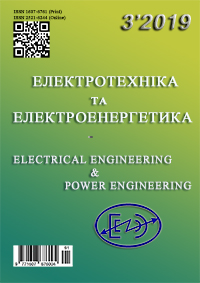ELECTROMAGNETIC PROCESSES WITH DIRECT EXCITATION OF SERIAL RESONANT CIRCUIT BY RECTANGULAR VOLTAGE PULSES
DOI:
https://doi.org/10.15588/1607-6761-2019-3-1Keywords:
serial resonant circuit, rectangular voltage pulses, active-reactive circuit Q-factor, voltage reso-nanceAbstract
Purpose. Obtaining the analytical amplitude-time dependencies of exited currents and numerical estimations of their characteristics with direct excitation of resonant sequential active-reactive circuit by periodic series of rectangular unipolar or oscillating voltage pulses.
Methodology. The mathematical apparatus of the theory of electric circuit in transients calculations when connecting serial resonant circuits. Numerical estimations of the occurring electromagnetic processes characteristics.
Findings. The amplitude-time forms of current in a series active-reactive circuit are determined during its resonant excitation by the periodic series of the rectangular unipolar or oscillating voltage pulses with a resonant repetition rate. Numerical estimates of the characteristics of the excited currents are performed. The somewhat higher efficiency of unipolar excitation of harmonic processes is noted in comparison with the excitation of periodic voltage pulses by oscillating sequences. It is shown that with an increase in the quality factor of the resonance circuit - Q, the contribution of the higher spectral components, regardless of the input voltage type, substantially decreases, and for Q >> 1 the excited current becomes strictly harmonic.
Originality. The scientific novelty of the present work consists in obtaining analytical amplitude-time dependences and numerical estimates for the excited currents by directly connecting the anharmonic voltage source to a series resonant circuit and is initiated by practical tasks in the development of electrical devices, the real effectiveness of which is possible only under conditions close to resonant.
Practical value. The obtained expressions for the currents excited by directly connecting the anharmonic voltage source to the series resonant active-reactive circuit, and the results of the analysis are necessary for the design of electrical devices with resonant components. It seems very promising in the direction of further research to solve the problem and analyze processes in a system of two inductively coupled series resonant circuits excited by a time sequence of anharmonic signals.References
[1] Pavlov, H. V., Obrubov, A. V. (2014). Rezonansnye preobrazovateli v energoeffektivnykh elektrotekhnicheskikh sistemakh [Resonant amplifiers in energy efficient electrical engineering systems]. Energosberezhenie, energetika, energoaudit. Sp. is. 1, 9 (128), 13-23.
[2] Agheb, E., Hayati Soloot, A., Niayesh, K., Hashemi, E. & Jadidian, J. (2009). On the Optimum Design of Air-Cored Tesla Transformers. Acta Physica Polonica. 115 (6), 1152-1154.
[3] Osipov, A. V., Shyniakov, Yu. A., Chernaya, Yu. A. & Tkachenko, A. A. (2015). Rezonansnye preobrazovateli energii solnechnoy batarei [Resonant energy transformers in solar battery] «Federal'noe gosudarstvennoe byudzhetnoe uchrezhdenie vysshego obrazovaniya» Publ. Reshetnevskie chteniya. 1, 19, 290-292.
[4] Iavorskii, B. M., Detlaf, A. A. & Lebedev, A. K. (2006). Spravochnik po fizike dlia inzhenerov i studentov VUZov. Moscow: Oniks Publ.
[5] Benenson, W., Harris, J. W., Stoker, H., & Lutz H. (2002). Handbook of Physics. New York: Springer Publ.
[6] Denicolai, M. (2001). Tesla transformer for experimentation and research. Helsinki university of Technology.
[7] Rezonansnyy usilitel' moshchnosti toka promyshlennoy chastoty [Resonant power amplifier of industrial frequency current] (2019). Available at: http://allpowr.su/ru/33
[8] Mesyats, G. A. (2004). Impul'snaya energetika i elektronika. M: Nauka.
[9] Bakalov, V. P., Dmitrikov V. F., & Kruk B. I. (2007). Osnovy teorii tsepey 3rd ed. M: Goryachaya liniya – Telekom.
[10] Craven, R. M., Smith, I. R. & Novac, B. M. (2014). Optimizing the secondary coil of a tesla transformer to improve spectral purity. IEEE Transactions on Plasma Science, 42 (1), 143-148.
[11] Naidu, M. S. & Kamaraju, V. (2013). High Voltage Engineering 3rd edition. N. Y.: Tata McGraw-Hill Publishing Company Limited.
[12] Batygin, Yu. V., e.a. Sposib indukcijnogo nagrivu metalevyh elementiv avtomobil'nyh konstrukcij [Method for induction heating of metal automobile construction elements]. Patent Ua, no. 95481, 2014.
[13] Induktor, induktsionnoe oborudovanie [Inductor, induction equipment] (2019). Available at: индуктор-авто.рф.
[14] Batygin, Yu. V., Serikov, G. S., Sinderuk, S. A. (2018). Rezonansnyy usilitel' elektricheskoy moshchnosti. Osnovnye raschetnye sootnosheniya [Rasonant amplifier. The main calculation relations]. Vіsnik Natsіonal'nogo tekhnіchnogo unіversitetu «KhPІ». Serіya: Problemi udoskonalennya elektrichnikh mashin і aparatіv. Teorіya і praktika.: zb.nauk. pr. 32(1308), 59-63.
[15] Batygin, Yu. V., Serikov, G. S., Sinderuk, S. A. (2018). Rezonansnyy usilitel' elektricheskoy moshchnosti. Eksperimental'nye issledovaniya [Resonant amplifier. Experimental research]. Luts'k: LNTU. Zb.naukovikh prats': Perspektivnі tekhnologії ta priladi, 13, 18-24.
[16] Atabekov, G. I. (2006). Osnovy teorii tsepei. L: Energiia.
[17] Batygin, Yu. V., Serikov, G. S., Sinderuk, S. A., Strelnikova, V. A. & Usmonov, E. R. (2019). Resonant reactive power amplifier. Analysis of electromagnetic processes. Electrical Engineering and Power Engineering, 2, 34-42.
[18] Demirchyan, K. S., Neyman, L. R., Korovkin, N. V. & Chechurin, V. L. (2003). Teoreticheskie osnovy elektrotekhniki 4th ed., 1, Spb.: «Piter».
[19] Korn, G. A., Korn, T. M. (2000). Mathematical Handbook for Scientists and Engineers. Mineola, N.Y.: Dover Publications.
Downloads
Published
How to Cite
Issue
Section
License
Copyright (c) 2019 Yu.V. Batygin, E.A. Chaplygin, S.O. Shinderuk, V.A. Strelnikova, E.YE. Neskreba

This work is licensed under a Creative Commons Attribution 4.0 International License.
Creative Commons Licensing Notifications in the Copyright Notices
Authors who publish with this journal agree to the following terms:
Authors retain copyright and grant the journal right of first publication with the work simultaneously licensed under aCreative Commons Attribution License that allows others to share the work with an acknowledgement of the work's authorship and initial publication in this journal.
Authors are able to enter into separate, additional contractual arrangements for the non-exclusive distribution of the journal's published version of the work (e.g., post it to an institutional repository or publish it in a book), with an acknowledgement of its initial publication in this journal.
Authors are permitted and encouraged to post their work online (e.g., in institutional repositories or on their website) prior to and during the submission process, as it can lead to productive exchanges, as well as earlier and greater citation of published work.

